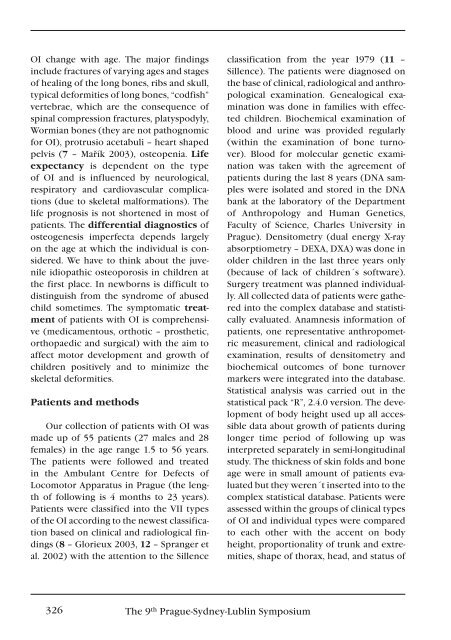Supplementum 3+4/2007 - SpoleÄnost pro pojivové tkánÄ›
Supplementum 3+4/2007 - SpoleÄnost pro pojivové tkánÄ›
Supplementum 3+4/2007 - SpoleÄnost pro pojivové tkánÄ›
Create successful ePaper yourself
Turn your PDF publications into a flip-book with our unique Google optimized e-Paper software.
OI change with age. The major findings<br />
include fractures of varying ages and stages<br />
of healing of the long bones, ribs and skull,<br />
typical deformities of long bones, “codfish”<br />
vertebrae, which are the consequence of<br />
spinal compression fractures, platyspodyly,<br />
Wormian bones (they are not pathognomic<br />
for OI), <strong>pro</strong>trusio acetabuli – heart shaped<br />
pelvis (7 – Mařík 2003), osteopenia. Life<br />
expectancy is dependent on the type<br />
of OI and is influenced by neurological,<br />
respiratory and cardiovascular complications<br />
(due to skeletal malformations). The<br />
life <strong>pro</strong>gnosis is not shortened in most of<br />
patients. The differential diagnostics of<br />
osteogenesis imperfecta depends largely<br />
on the age at which the individual is considered.<br />
We have to think about the juvenile<br />
idiopathic osteoporosis in children at<br />
the first place. In newborns is difficult to<br />
distinguish from the syndrome of abused<br />
child sometimes. The symptomatic treatment<br />
of patients with OI is comprehensive<br />
(medicamentous, orthotic – <strong>pro</strong>sthetic,<br />
orthopaedic and surgical) with the aim to<br />
affect motor development and growth of<br />
children positively and to minimize the<br />
skeletal deformities.<br />
Patients and methods<br />
Our collection of patients with OI was<br />
made up of 55 patients (27 males and 28<br />
females) in the age range 1.5 to 56 years.<br />
The patients were followed and treated<br />
in the Ambulant Centre for Defects of<br />
Locomotor Apparatus in Prague (the length<br />
of following is 4 months to 23 years).<br />
Patients were classified into the VII types<br />
of the OI according to the newest classification<br />
based on clinical and radiological findings<br />
(8 – Glorieux 2003, 12 – Spranger et<br />
al. 2002) with the attention to the Sillence<br />
classification from the year 1979 (11 –<br />
Sillence). The patients were diagnosed on<br />
the base of clinical, radiological and anthropological<br />
examination. Genealogical examination<br />
was done in families with effected<br />
children. Biochemical examination of<br />
blood and urine was <strong>pro</strong>vided regularly<br />
(within the examination of bone turnover).<br />
Blood for molecular genetic examination<br />
was taken with the agreement of<br />
patients during the last 8 years (DNA samples<br />
were isolated and stored in the DNA<br />
bank at the laboratory of the Department<br />
of Anthropology and Human Genetics,<br />
Faculty of Science, Charles University in<br />
Prague). Densitometry (dual energy X-ray<br />
absorptiometry – DEXA, DXA) was done in<br />
older children in the last three years only<br />
(because of lack of children´s software).<br />
Surgery treatment was planned individually.<br />
All collected data of patients were gathered<br />
into the complex database and statistically<br />
evaluated. Anamnesis information of<br />
patients, one representative anthropometric<br />
measurement, clinical and radiological<br />
examination, results of densitometry and<br />
biochemical outcomes of bone turnover<br />
markers were integrated into the database.<br />
Statistical analysis was carried out in the<br />
statistical pack “R”, 2.4.0 version. The development<br />
of body height used up all accessible<br />
data about growth of patients during<br />
longer time period of following up was<br />
interpreted separately in semi-longitudinal<br />
study. The thickness of skin folds and bone<br />
age were in small amount of patients evaluated<br />
but they weren´t inserted into to the<br />
complex statistical database. Patients were<br />
assessed within the groups of clinical types<br />
of OI and individual types were compared<br />
to each other with the accent on body<br />
height, <strong>pro</strong>portionality of trunk and extremities,<br />
shape of thorax, head, and status of<br />
326 The 9 th Prague-Sydney-Lublin Symposium
















